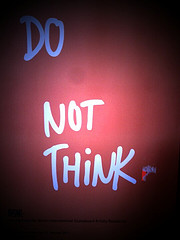|
|
|
Archive for November, 2017
Wednesday, November 15th, 2017
Our apologies for missed and late postings. We were still having technical issues, but they’ve all been handled. (I hope!)
 I’m ambivalent about AI. I’m ambivalent about AI.
On one hand, some of the things it can do, such as enable an iPhone to do an ultrasound scan, are amazing and encouraging.
Earlier this year, vascular surgeon John Martin was testing a pocket-sized ultrasound device developed by Butterfly Network, (…) he knew that the dark, three-centimeter mass he saw did not belong there. “I was enough of a doctor to know I was in trouble,” he says. It was squamous-cell cancer.
On the other hand, AI is full of human bias, whether intentional or not.
AI tends to be fairly unflattering to anyone with a darker skin tone, and that using AI to judge female beauty is a pretty questionable goal. (…) MakeApp’s unflattering, malfunctioning AI is the latest in a long line of AI controversies: Snapchat’s offensive Bob Marley filter, FaceApp’s “black” filters, and smartphone cameras that lighten your skin by default.
There was a time when the phrase “seeing is believing” was tightly connected to reality.
That connection became shaky with the advent of Photoshop and has been rapidly deteriorating ever since.
Enter AI in the form of the generative adversarial networks (GAN).
But images and sound recordings retain for many an inherent trustworthiness. GANs are part of a technological wave that threatens this credibility.
GANs are poised to escalate fake news, discredit evidence, legal, medical, etc., and force you to question everything — or believe blindly.
Image credit: brett jordan
Posted in Communication, Culture, Innovation | 1 Comment »
Monday, November 13th, 2017
It’s amazing to me, but looking back over more than a decade of writing I find posts that still impress, with information that is as useful now as when it was written.
Golden Oldies are a collection of what I consider some of the best posts during that time.
Who’d a thunk it? A world I wrote about 5 years ago that I hoped I wouldn’t live to see has already happened and I’m still here. Bummer.
Read other Golden Oldies here.
 Two stories today made me really happy. Two stories today made me really happy.
Happy that I won’t be around to see the world that the Silicon Valley mentality is working frantically to make happen. (I say ‘mentality’ because startups are all over as is the mindset described.)
It’s a world of instant solutions, from quasi-immortality, postmortem tweets from soon-to-be-launched LivesOn, to futurist Ayesha Khanna’s idea for smart contact lenses that would make homeless people disappear from view—out of sight/out of mind.
Solutionists err by assuming, rather than investigating, the problems they set out to tackle. Given Silicon Valley’s digital hammers, all problems start looking like nails, and all solutions like apps.
And then there is Seesaw, which allows you to “crowdsource absolutely every decision in your life” and practically guarantees siloed, homogenized attitudes over the long-term.
The drive seems to be to avoid thinking in general, let alone any of the less comfortable deep thinking required to mature and develop anything vaguely resembling wisdom.
Leszek Kolakowski argued that, given that we are regularly confronted with equally valid choices where painful ethical reflection is in order, being inconsistent is the only way to avoid becoming a doctrinaire ideologue who sticks to an algorithm. For Kolakowski, absolute consistency is identical to fanaticism.
Or as Emerson said long before the rise of today’s technology, “A foolish Consistency is the hobgoblins of little minds, adored by little statesmen, philosophers, and divines. With consistency, a great soul simply has nothing to do.”
The main problem with so many innovators is that they want to solve problems with an algorithm, which ignores the entire messy human equation; much like medicine desperately wants to believe that one-dose-fits-all.
Nor, in the rush to innovate, do they give much thought as to the longer-term effects of their miracles.
The interactive dialog provided by digital media was hailed as a way to draw millions more into the dialog, which sounds great until you look at the real effect of negative comments on stories.
Comments from some readers, our research shows, can significantly distort what other readers think was reported in the first place. (…) The results were both surprising and disturbing. Uncivil comments not only polarized readers, but they often changed a participant’s interpretation of the news story itself.
Turns out it’s not so much the comment, but the tone that has the greatest effect.
So. No discussion, no disagreement within your little world, no ethical dilemmas, no deep thinking, mental struggle, stretching or growing.
Maybe no innovation.
Is this the world in which you want to live?
Image credit: Igor Schwarzmann
Posted in Golden Oldies, Innovation, Personal Growth | No Comments »
Friday, November 10th, 2017
A Friday series exploring Startups and the people who make them go. Read all If the Shoe Fits posts here.
 This is a short post, because it links to a longer one by Henry Mintzberg that should be required reading for every entrepreneur. This is a short post, because it links to a longer one by Henry Mintzberg that should be required reading for every entrepreneur.
Three years ago I questioned the profits entrepreneurs derived from building incompatible systems for the electronic medical records (EMR) systems mandated by the Affordable Care Act.
The money in play is substantial; privately held Epic is one of the largest suppliers and its founder, Judith R. Faulkner, is supposed to be worth around $2.3 billion.
When you’re making that kind of money who worries about lives ruined or lost because of EMR incompatibility?
Last summer Ryan wrote a thoughtful post comparing ‘enough’, on a personal level, to an empty hole that needs filling and ending with this comment.
Perhaps there is never enough.
Perhaps all that matters is what you are filling up that hole with.
Mintzberg is the latest to write on the subject, but with far more knowledge and authority than most, and his focus on staying private, instead of IPOing truly changes the conversation: Enough of MORE: Better is better
We would do well by shifting our economies from MORE toward better. While MORE is about quantities, better is about qualities. They lift us up instead of dragging us down. We can invest our efforts and our resources in durable products, healthier foods, personalized services, properly-funded education. Rather than reducing employment, a shift to better can enhance it, with higher paying jobs in healthier enterprises. When we work better, we feel better, and so we do better and live better. Our societies become better…and sustainably democratic.
Any of these moves requires moving profit out of the top slot, which won’t be easy.
I looked up the example Mintzberg provided at the end of his post and it is proof of how difficult it will be to change the money focus.
…many shareholders expressed concern on Wednesday that the Germanwings tragedy risked distracting management from its turnaround efforts.
The “distraction” involved 149 intentional murders and one suicide.
More recently, money trumped responsibility (pun intended) for Facebook, Google and Twitter during the presidential election.
Hard research from Harvard provides proof that money isn’t the focus of successful startups..
If what really interests you is building a company that actually does make a difference and helps change the world, while providing you and yours a happy life along with the money, then read Mintzberg and seriously consider his advice.
Image credit: HikingArtist
Posted in Compensation, Culture, If the Shoe Fits, Personal Growth | No Comments »
Wednesday, November 8th, 2017

Yesterday we looked at some terrible management advice; today we’ll check out the unstated, totally ignored elephant in the room when it comes to hiring.
When AI tells you the success of your new hire, before you hire them is a typical misleading media headline.
While the experts talk about the enormous amount of candidate data available online that goes way beyond education, skills, experience and even background checks, and AI’s ability to correlate and to some extent, interpret it, they agree that it still requires human involvement.
But comprehending someone’s motivations and soft skills – attentiveness, nimbleness or assertiveness — requires a level of interpretation that some recruiters don’t believe machines have just yet. (…)
That type of intuition is already being built into machines. In the hiring process, the data to analyze is flooding in and it will require powerful and intelligent machines to digest it all; companies are realizing they need to be more precise about their hiring needs in order to get answers from machines; and already we’re seeing some machines conduct simple tasks, such as administrative matching.
Once again the elephant is ignored.
All focus is on candidates, while the elephants are completely ignored.
What are the elephants?
The manager and the culture they create in their individual domain all the way down to a team leader.
That’s why the person who soars as a star working for X can easily burn out and crash after going to work for Y and vice versa.
The elephants aren’t new; they’ve always been around and even occasionally written about, but rarely credited with candidate success or failure.
Will/can AI change that?
Unlikely, because, as seen in hundreds of examples, self-analysis is rarely accurate and how someone wants to be managed is not necessarily predictive of how they will manage others.
So, as long as the elephants continue to roam and thrive, it remains unlikely that AI will actually be able to predict hiring success.
Image credit: David Blackwell
Posted in Culture, Hiring, Personal Growth | No Comments »
Tuesday, November 7th, 2017
 Some of the worst management advice I’ve heard/read recently comes from Anthony Middleton, former Special Forces Operator and co-author of “SAS: Who Dares Wins.” Some of the worst management advice I’ve heard/read recently comes from Anthony Middleton, former Special Forces Operator and co-author of “SAS: Who Dares Wins.”
He said; “How do I earn the respect of a group that I don’t know? That’s pretty simple. I go in with a voice of authority. I go in and I show them exactly why I’m their leader. When I give my first set of orders, I’m actually going to get involved with those first set of orders, I’m going to get in there, get my hands dirty.”
On handling people with big egos, the Former SBS Operator says: “I play to their egos, sometimes the best thing to do is let them learn from their mistakes. What I do is I slowly let them trip up, I’ll slowly let them stumble, and then I’ll take hold of them, break them down and build them back up to where they need to be.”
In other words, set them up to fail.
As to building them up, who decides on “where they need to be?”
Given today’s workforce, the only positive thing I can see managers who take this advice accomplishing is to improve their hiring skills.
Sadly, I’ve worked with many people who, for whatever reason, were broken, but not built back up. (I’ve always believed there is a special circle in the Inferno for bosses who intentionally damage their people.)
Knowing how opinionated (prejudiced) I am on this subject, I asked KG, who is a Boomer, and Ryan, who is a Millennial, what they thought. (In case you’re wondering, I’m on the cusp between the Silent Generation and the Boomers.)
From KG Charles-Harris.
The special forces is like investment banking; highly trained and motivated individuals, strong egos, high impact consequences. When dealing with millions of dollars or serious life & death situations (include surgeons in this — my brother is one) with small time considerations, the need for decisiveness and people following orders escalates. There is little latitude for more collaborative or iterative decision making.
While often necessary in the circumstances described above (btw, this wasn’t an exhaustive list of professions), in most organizations and groups the command and control type of leadership would produce worse results. In fact, in the special forces, surgery and investment banking there are deep postmortems and other tools that are utilized to foster organizational learning.
From Ryan Pew.
The advice he is giving is something I have heard time and time again in a military setting where hierarchy is clearly defined and respected. I won’t say it doesn’t hold water in non-military settings but you have to adapt it when dealing with folks who are not as rigid.
In the first bold phrase, I guess I would assume that he is stepping into a new group already defined as the leader. In this case, it can make sense to have a voice of authority, be confident and I like that he backs it up by saying he will do the work with them rather than dictate from afar. However, that can be taken too far if it sounds like a dictatorial tone of voice, that won’t fly long term.
The second phrase is something I have seen during my time in the Marines. Senior Marines will allow junior Marines to make mistakes early on to learn from them. Typically this is done in a controlled environment before combat operations. The expectation that once we get into combat those rookie mistakes will no longer be there. It helps to build confidence in the young Marine and instill in them a strong work ethic. The breaking down aspect is something also done in a controlled environment.
BUT I WANT TO SAY RIGHT NOW THAT THIS IS INSANITY IF YOU THINK IT WORKS IN CIVILIAN LIFE.
I shouted that to be sure we are all clear here. In the military, you need to be a unified group lacking individuality. This builds cohesion and a willingness to follow orders immediately, even when you know they may kill you. The advantage is obvious, you have a superior fighting unit and ensure that weakness is pounded out.
That will not work at the office. If you have a boss who starts breaking people down emotionally or mentally only to so-called build them back up in the preferred image you will have a lawsuit or worse. Besides, offices do not need a singular mindset, they need creativity and individuality to thrive.
This boss would be a psychopath and it sounds like this guy is just saying stuff to sell books without utilizing it in real-world settings.
So simple answer, this works in the military, not real life.
So. Three generations, raised in substantially different worlds, but all agreeing that if you choose to follow Middleton’s advice you do so at your own peril.
Image credit: Robert Payne
Posted in Culture, Ducks In A Row, Motivation, Retention | No Comments »
Monday, November 6th, 2017
It’s amazing to me, but looking back over more than a decade of writing I find posts that still impress, with information that is as useful now as when it was written.
Golden Oldies are a collection of what I consider some of the best posts during that time.
Curation has gotten much worse over the last two years since this was written. Facebook curates your news feed based on your profile and online actions, so you see mostly items — whether real or fake — that are in line with your worldview. Facebook, Google, Amazon, Twitter and most other sites show you “targeted ads” based on the the cornucopia of personal information at their fingertips.
The result is a world that is narrowing and, in doing so, becomes more harrowing.
Read other Golden Oldies here.

Earlier this month I shared a conversation with a founder who believes he can lead only one type of person.
It wasn’t that surprising, because the more things are curated the more we hear from and cleave to people like ourselves.
There’s no question that curation reinforces opinions, while eliminating conflicting ones, narrows people beyond from where they started and acts like fertilizer to unconscious bias and outright bigotry.
But isn’t college supposed to help change that by exposing students to people with different beliefs, experiences, attitudes, etc.?
Several years ago a couple of startups gave the college-bound a way to curate their roommates, so they could be sure not to be exposed to ideas, attitudes or upbringing not in sync with their current thinking.
Mangers have been doing this for decades by thoughtlessly hiring people like themselves, so they can stay within their personal comfort zones.
Now college students are taking the concept much further with the demand for “safe spaces.”
Safe spaces are an expression of the conviction, increasingly prevalent among college students, that their schools should keep them from being “bombarded” by discomfiting or distressing viewpoints. Think of the safe space as the live-action version of the better-known trigger warning, a notice put on top of a syllabus or an assigned reading to alert students to the presence of potentially disturbing material. (…)
Eric Posner, a professor at the University of Chicago Law School commented, “Perhaps overprogrammed children engineered to the specifications of college admissions offices no longer experience the risks and challenges that breed maturity,” But “if college students are children, then they should be protected like children.”
This need for safety and zero-level tolerance for discord makes me wonder what will happen to the current college generations when they venture into the workplace, let alone the rest of the real world.
Image credit: Deb Nystrom
Posted in Culture, Golden Oldies, Personal Growth | No Comments »
Saturday, November 4th, 2017
A Friday series exploring Startups and the people who make them go. Read all If the Shoe Fits posts here.
 Winning takes many forms, as Ryan pointed out yesterday. Winning takes many forms, as Ryan pointed out yesterday.
Let’s face it, we are not all going to be the next Elon Musk or Jeff Bezos.
But there seems to be plenty of room for us all to push a bit harder each day and surround ourselves with winners.
It is up to us to make that happen.
Not all winners desire to be founders anymore than all founders are winners.
I doubt anyone would/could/should minimize the abilities, skills, intelligence, and sheer grit that lands a person in a top senior role at a multibillion dollar tech company, such as Microsoft.
Achieving positions at that level are neither accidental nor serendipitous.
Now, imagine a future in which you are a winner of whatever kind and writing the summary paragraph of your LinkedIn profile.
What would you say when summing up what you did and how you accomplished it? What would you consider your major accomplishments?
Would it read anything like this? (Emphasis mine.)
“I am passionate about building technology that gets out of the way so you can focus on what matters most. My mantra ‘people first, technology second’ has been the driving force in my career. My focus has been leading teams and incubating new technologies and experiences to re-imagine the platform for intelligent work. In my career, I’ve helped build products, including Office, Windows, Internet Explorer, Xbox and Surface, that touch more than a billion people every day. As a leader, it’s important that my door always be open — to embrace everyone’s individual perspective, personality, style and abilities to makes my teams stronger — and creating a culture that the best ideas can come from anyone and anywhere.”
Is this someone worth emulating? Someone you’d want to hire?
Would your answer change when you learned this someone is a woman?
Because it is; she is Julie Larson-Green.
And it is the last 14 words of her summary that truly proclaim her a winner — by any standard.
Image credit: HikingArtist
Posted in If the Shoe Fits, Personal Growth, Role Models | No Comments »
Thursday, November 2nd, 2017

Winning and competition are fundamental to our lives.
It starts early with your siblings fighting over the same toy and progresses to fighting with your spouse over the TV remote.
It is also something that enables us to push past what our preconceived limits are. I am sure you have had a time when you thought you could do no more, but then you see someone else succeeding a bit more and you push on.
The competition was what helped you achieve your goals and at the end of the day, everyone is better for it.
I have been watching the World Series, full disclaimer I am not a baseball guy, but I do love to see a winner. I happened to be in Houston for the start of the series and that determined the team I would root for, so for the past week or so I have been an Astros fan.
As I watched the series I started to get invested in the lives of the players and what had enabled them to get to this grandest of stages. It was interesting to learn about their paths to the big league and what challenges they faced.
I learned an interesting fact from my wife this morning. Her high school friend is a relief pitcher for the Houston Astros by the name of Tony Sipp. I looked up his stats and as far as I can tell he didn’t pitch a single ball, but he will get a ring.
What I found to be interesting about his life, though, was the path he took to get to where he is. He is from Pascagoula, MS, where he also played for the football team that took home the state championship in 2000, so the guy was a talented athlete that had been around success. He then went on to play at the local Junior College before transferring to Clemson. From there it was a series of double and triple ball teams before entering the majors many years later.
As I read a bit about this guy, I am realizing that he is a winner. He isn’t the big time flashy name that you hear every day, he is the grind-it-out-and-pushes-on kind of guy. He has continued to push his way to the top of his talent and been able to surround himself with others who are doing the same thing.
I am pretty sure we can do the same thing in business.
Let’s face it, we are not all going to be the next Elon Musk or Jeff Bezos.
But there seems to be plenty of room for us all to push a bit harder each day and surround ourselves with winners.
It is up to us to make that happen.
Image credit: Wikipedia
Posted in Personal Growth, Ryan's Journal | No Comments »
Wednesday, November 1st, 2017
 I’ve written about deep thinking before; the kind of thinking that few have time for these days. I’ve written about deep thinking before; the kind of thinking that few have time for these days.
Even fewer have considered deep time, so I thought I’d share a wonderful article about someone who took the time to learn about something almost beyond human comprehension.
The Oldest Living Things project was motivated not by a narrow interest or a traditional scientific question, but by the idea of something called deep time. Deep time is not a precise demarcation in the way that geologic eras and cosmological epochs are. Rather, it’s a framework in which to consider timescales too long for our shallow, physical experience, and too big for our brains to process meaningfully. And why should they be able to? The earliest modern humans had a life expectancy of around 32 years. What evolutionary need would they have had to comprehend what 10,000 years felt like? What I wanted to do was to find or forge something relatable, something to help process and internalize deep time in a meaningful way: to feel expanses of time that we were not designed to feel.
How easily can you grasp the fact that this tree is just shy of 10,000 years old?
You may be wondering what’s the point? Why worry about something so far beyond the reach of the human mind?
Partly because the tech world is hyper-focused on finding a route to immortality.
But mainly, especially in light of that effort, because it’s a way to rein in the astounding egocentricity of our species.
Deep time is like deep water: We are constantly brought back to the surface, pulled by the wants and needs of the moment. But like exercising any sort of muscle, the more we access deep time, the more easily accessible it becomes, and the more likely we are to engage in long-term thinking. The more we embrace long-term thinking, the more ethical our decision-making becomes.
After all, meaning is not made of lone facts, lone people, or lone disciplines, nor is it found in the valuing of the objective over the subjective. Rather, meaning comes by way of knitting together a bigger picture, filled with color and texture, and meant to be felt and understood. We most fully understand what we can internalize—that which becomes part of us. The importance of specializing can’t be discarded, but working only within one discipline and strictly adhering to its rules is likely only to generate one kind of work, one kind of result.
We very well might end up missing the forest for the trees.
Read the article.
Think about it.
Image credit: Bored Panda
Posted in Communication, Personal Growth | No Comments »
|
 Subscribe to
Subscribe to
MAPping Company Success
About Miki 
Clarify your exec summary, website, etc.
Have a quick question or just want to chat? Feel free to write or call me at 360.335.8054
The 12 Ingredients of a Fillable Req
CheatSheet for InterviewERS
CheatSheet for InterviewEEs™
Give your mind a rest. Here are 4 quick ways to get rid of kinks, break a logjam or juice your creativity!
Creative mousing
Bubblewrap!
Animal innovation
Brain teaser
The latest disaster is here at home; donate to the East Coast recovery efforts now!
Text REDCROSS to 90999 to make a $10 donation or call 00.733.2767. $10 really really does make a difference and you'll never miss it.
And always donate what you can whenever you can
The following accept cash and in-kind donations: Doctors Without Borders, UNICEF, Red Cross, World Food Program, Save the Children
*/
?>About Miki
About KG
Clarify your exec summary, website, marketing collateral, etc.
Have a question or just want to chat @ no cost? Feel free to write
Download useful assistance now.
Entrepreneurs face difficulties that are hard for most people to imagine, let alone understand. You can find anonymous help and connections that do understand at 7 cups of tea.
Crises never end.
$10 really does make a difference and you’ll never miss it,
while $10 a month has exponential power.
Always donate what you can whenever you can.
The following accept cash and in-kind donations:
|





 Two stories today made me really happy.
Two stories today made me really happy. This is a short post, because it links to a longer one by
This is a short post, because it links to a longer one by 





